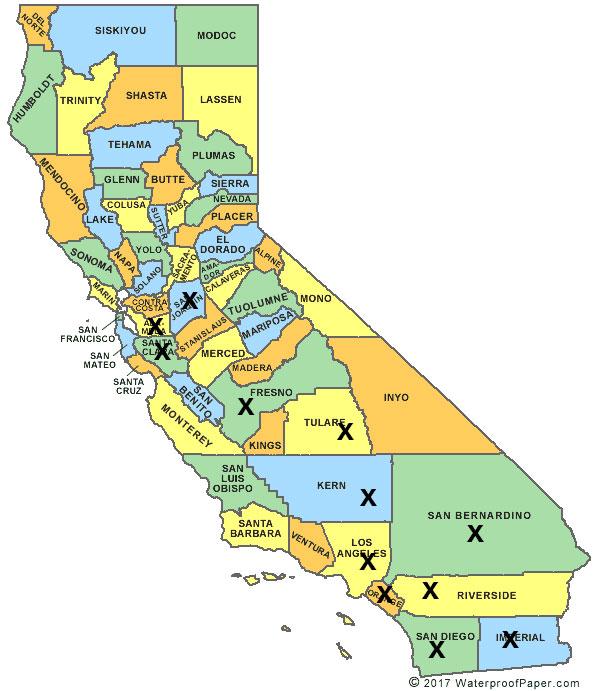California: One of these counties is not like the others.
The big story with COVID-19 the past few weeks has been, of course, the out-of-control increase in new cases (if not actual deaths...yet) from the virus in red states like Texas, Florida and especially Arizona which were relatively unscathed throughout the spring while the pandemic was raging across Northeastern blue states like New York, New Jersey and Rhode Island, as well as Michigan and California.
While most of the states being hit with the summer wave are historically Republican strongholds (the states being hit hardest in June/July also include Georgia, Arkansas, South Carolina, etc.), there's one important exception to this: California, which was hit early but which clamped down fairly quickly, has re-emerged as a major hot spot. So what gives?
Well, California is a big state, of course (both population-wise and geographically), so I decided to take a look at the county-level rate of growth per capita. 58 counties makes for a nearly unreadable chart (see my 50-state weekly updates), so I decided to go with just 12: The 12 California counties with more than 5,000 confirmed cases of COVID-19 as of July 8th. These 12 counties also include over 83% of all California cases, so I'm not too concerned about the other 46 at the moment.
The graph below follows the growth of COVID-19 across all 12 of these counties since March 20th per 1,000 residents. The total county populations range from as low as 181,000 (Imperial) to as high as over 10 million (Los Angeles County). As you can see, one county in particular sticks out:
OK, so what's going on in Imperial County, California? Well, here's a map of California with all 12 counties marked. Five of them are in central CA, the other 7 are in the southern third of the state. And Imperial County is right at the very bottom (next to San Diego...except that San Diego is actually the third from the bottom on the per capita graph above):
Now let's zoom the map out a bit to see what's next to Imperial County outside the state:
Oh. Riverside and San Bernadino Counties also border Arizona, but you still get the point. Viruses don't know what a border is.
Of course, there's a second border as well...and as noted in this June 22nd article (h/t to Kurt Squire via Twitter for the link), there's a whole other problem here as well:
From El Centro Regional Medical Center, the largest hospital in California’s Imperial County, it takes just 30 minutes to drive to Mexicali, the capital of the Mexican state of Baja California. The international boundary that separates Mexicali from Imperial County is a bridge between nations. Every day, thousands of people cross that border for work or school. An estimated 275,000 US citizens and green card holders live in Baja California. El Centro Regional Medical Center has 60 employees who reside in Mexicali and commute across the border, CEO Adolphe Edward told Julie Small of KQED.
Now these inextricably linked places have become two of the most concerning COVID-19 hot spots in the US and Mexico. While Imperial County is one of California’s most sparsely populated counties, it has the state’s highest per capita infection rate — 836 per 100,000, according to the California Department of Public Health. This rate is more than four times greater than Los Angeles County’s, which is second-highest on that list. Imperial County has 4,800 confirmed positive cases and 64 deaths, and its southern neighbor Mexicali has 4,245 infections and 717 deaths.
The COVID-19 crisis on the border is straining the local health care system. El Centro Regional Medical Center has 161 beds, including 20 in its intensive care unit (ICU). About half of all its inpatients have COVID-19, Gustavo Solis reported in the Los Angeles Times, and the facility no longer has any available ventilators.
...The state requires counties to have a seven-day testing positivity rate of no more than 8% to enter Expanded Stage 2.
Still, the Imperial County Board of Supervisors is pushing Governor Gavin Newsom for local control over its reopening timetable. The county has a high poverty rate — 24% compared with the statewide average of 13% — and “bills are stacking up,” Luis Pancarte, chairman of the board, said on a recent press call.
He worries that because neighboring areas like Riverside and San Diego have opened some businesses with physical distancing measures in place, Imperial County residents will travel to patronize restaurants and stores. This movement could increase transmission of the new coronavirus, just as reopening Imperial County too soon could as well.
How to support my healthcare wonkery:
1. Donate via ActBlue or PayPal
2. Subscribe via Substack.
3. Subscribe via Patreon.






